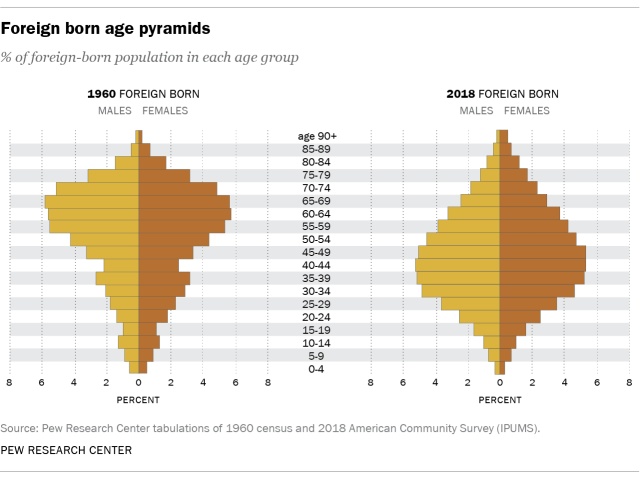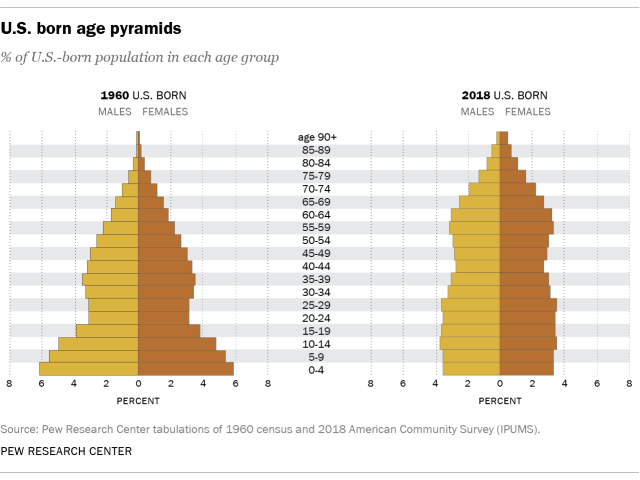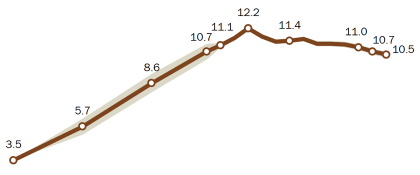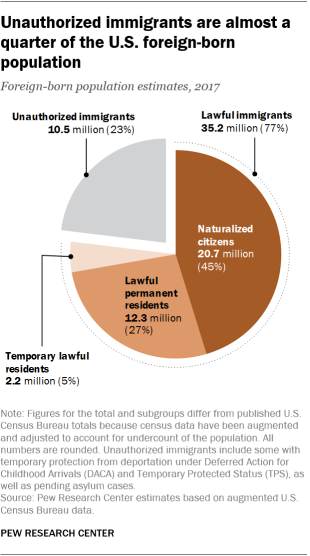Try our email course on U.S. immigration

Learn about immigration through five short lessons delivered to your inbox every other day. Sign up now!
There were a record 44.8 million immigrants living in the U.S. in 2018, making up 13.7% of the nation’s population. This represents a more than fourfold increase since 1960, when 9.7 million immigrants lived in the U.S., accounting for 5.4% of the total U.S. population.
For facts on Latinos in the United States, see our profile on U.S. Hispanics.
For details on our regional grouping of countries, see our “Countries by regional classification” document.
Click the categories below to see charts and data.
Population & age | Origin regions | Time in the U.S. & generations
Language use & education | Unauthorized immigrant population
Population & age
Foreign-born population in the United States, 1850-2018
Foreign-born population, in millions
| Year | Foreign-born population, in millions |
|---|---|
| 1850 | 2.2 |
| 1860 | 4.1 |
| 1870 | 5.6 |
| 1880 | 6.7 |
| 1890 | 9.2 |
| 1900 | 10.3 |
| 1910 | 13.5 |
| 1920 | 13.9 |
| 1930 | 14.2 |
| 1940 | 11.6 |
| 1950 | 10.3 |
| 1960 | 9.7 |
| 1970 | 9.6 |
| 1980 | 14.1 |
| 1990 | 19.8 |
| 2000 | 31.1 |
| 2010 | 39.9 |
| 2013 | 41.3 |
| 2014 | 42.2 |
| 2015 | 43.2 |
| 2016 | 43.7 |
| 2017 | 44.4 |
| 2018 | 44.8 |
Source: U.S. Census Bureau population estimates and Pew Research Center tabulations of 2010, 2013-2018 American Community Surveys (IPUMS).
PEW RESEARCH CENTER
The foreign-born population residing in the U.S. reached a record 44.8 million, or 13.7% of the U.S. population, in 2018. This immigrant population has more than quadrupled since the 1960s, when the 1965 Immigration and Naturalization Act took effect. Though growth has begun to slow in recent years, the number of immigrants living in the United States is projected to almost double by 2065.


The age structure of the U.S. immigrant population has changed alongside the changing immigrant origin regions. As the largest group of immigrants shifted from Europeans, Canadians and other North Americans to Mexicans, the largest age group moved from ages 65-69 in 1960 to ages 40-44 in 2018. Today, European, Canadian and other North American immigrants tend to be older, with a median age of 53 and 54 respectively in 2018. Mexican immigrants are among the youngest, with a median age of 43. The age distribution of the U.S.-born population has also transformed. In 1960, towards the end of the Baby Boom, the population was younger than in 2018, when these age groups were much more evenly dispersed.
Origin regions
% of foreign-born population residing in the U.S. who were born in …
| Year | Mexico | Other Latin America | Asia | Europe/Canada and other North America |
|---|---|---|---|---|
| 1960 | 6% | 3% | 4% | 84% |
| 1970 | 8% | 11% | 7% | 68% |
| 1980 | 16% | 16% | 16% | 42% |
| 1990 | 22% | 21% | 22% | 26% |
| 2000 | 29% | 22% | 23% | 19% |
| 2010 | 29% | 24% | 25% | 14% |
| 2015 | 27% | 24% | 27% | 13% |
| 2018 | 25% | 25% | 28% | 13% |
Source: Pew Research Center tabulations of 1960-2000 decennial censuses and 2010, 2015-2018 American Community Surveys (IPUMS).
Note: Other Latin America includes Central America, South America and the Caribbean. Asia includes Central, East, Southeast, and South Asia.
PEW RESEARCH CENTER
The regions of origin for immigrant populations residing in the U.S. have dramatically shifted since the passage of the 1965 Immigration and Naturalization Act. In 1960, 84% of immigrants living in the U.S. were born in Europe, Canada or other North American countries, while only 6% were from Mexico, 4% from Asia, 3% from the rest of Latin America and 3% from other areas. Immigrant origins now differ drastically, with European, Canadian and other North American immigrants making up only a small share of the foreign-born population (13%) in 2018. Asians (28%), Mexicans (25%) and other Latin Americans (25%) each make up about a quarter of the U.S. immigrant population, followed by 9% who were born in another region.
Time in the U.S. & generations
% of foreign-born population who have lived in the U.S. …
| Year | 0 to 10 years | Over 10 years |
|---|---|---|
| 1970 | 30.6% | 69.4% |
| 1980 | 39.6% | 60.4% |
| 1990 | 43.8% | 56.2% |
| 2000 | 42.4% | 57.6% |
| 2010 | 34.7% | 65.3% |
| 2013 | 28.4% | 71.6% |
| 2014 | 28.1% | 71.9% |
| 2015 | 27.9% | 72.1% |
| 2016 | 27.6% | 72.4% |
| 2017 | 27.8% | 72.2% |
| 2018 | 27.5% | 72.5% |
Source: Pew Research Center tabulations of 1970-2000 decennial censuses and 2010, 2013-2018 American Community Surveys (IPUMS).
PEW RESEARCH CENTER
The nation’s immigrants are more settled today than they were in 1990, when the share of those who had arrived within the past 10 years peaked at 44%. Now, the amount of time that immigrants have spent in the U.S. has grown. In 2018, 73% of immigrants had lived in the U.S. for over 10 years, up from 56% in 1990 (but similar to the share in 1970.)
% of immigrants arriving in the U.S. in each year who are …
| Year | Hispanic | Asian |
|---|---|---|
| 2000 | 47.6% | 22.5% |
| 2001 | 44.8% | 22.3% |
| 2002 | 48.4% | 24.7% |
| 2003 | 51.4% | 23.2% |
| 2004 | 50.2% | 24.1% |
| 2005 | 48.0% | 24.8% |
| 2006 | 42.8% | 29.4% |
| 2007 | 35.6% | 32.9% |
| 2008 | 35.1% | 32.2% |
| 2009 | 32.0% | 35.9% |
| 2010 | 29.5% | 38.1% |
| 2011 | 26.5% | 39.0% |
| 2012 | 27.9% | 38.0% |
| 2013 | 28.0% | 37.7% |
| 2014 | 30.4% | 37.3% |
| 2015 | 31.4% | 36.2% |
| 2016 | 32.7% | 33.7% |
| 2017 | 30.9% | 35.2% |
| 2018 | 31.4% | 36.7% |
Source: Pew Research Center tabulations of 2001-2018 American Community Surveys (IPUMS).
Note: Figures for 2000 to 2004 are based on the household population and do not include arrivals residing in group quarters. For 2000-2017, the shares are computed using immigrants who arrived in the year before the ACS surveys of 2001-2018; for 2018, based on those arriving in 2018 in the 2018 ACS. Race and ethnicity based on self-reports. Asians include only single-race non-Hispanics. Hispanics are of any race.
PEW RESEARCH CENTER
Starting as early as 2010, more Asian immigrants than Hispanic immigrants have arrived annually in the U.S., a reversal of historical trends. In the early 2000s, the number of newly arrived Hispanic immigrants greatly outnumbered newly arrived Asian immigrants. Around the time of the Great Recession, Latin American immigration declined sharply, especially from Mexico.
CORRECTION (Sept. 21, 2020): An update to the methodology used to tabulate figures in the chart above has changed all figures from 2001 and 2012. This new methodology has also allowed the inclusion of the figure from 2000. Futhermore, the earlier version of the chart incorrectly showed the partial year shares of Hispanic and Asian recent arrivals in 2015; the corrected complete year shares are 31% and 36%, respectively.
% of U.S. population who are __ immigrants
| Year | 1st generation | 2nd generation |
|---|---|---|
| 1900 | 13.7 | 20.8 |
| 1910 | 14.6 | 20.1 |
| 1920 | 12.7 | 20.6 |
| 1930 | 11.3 | 20.1 |
| 1940 | 8.5 | 18.8 |
| 1950 | 6.9 | 16.2 |
| 1960 | 5.6 | 13.8 |
| 1970 | 4.8 | 12 |
| 1980 | 6.2 | 10.3 |
| 1990 | 8.2 | 9.6 |
| 2000 | 11.4 | 10 |
| 2006 | 12.1 | 10.5 |
| 2010 | 12.7 | 11.3 |
| 2015 | 13.3 | 12.1 |
| 2016 | 13.5 | 12 |
| 2017 | 13.7 | 12 |
| 2018 | 14.1 | 12.3 |
Source: 1900-1950 data from Edmonston and Passel (1994); 1960-2000 numbers from Pew Research Center estimates of adjusted census data consistent with historical estimates and projections; 2005-2018 data from Pew Research Center tabulations of March CPS ASEC (IPUMS).
Note: First-generation immigrants are those born outside the U.S. The second generation are those born in the U.S. with at least one immigrant parent. Some data for 1960-2015 differ slightly from previous versions of this chart for historical consistency.
PEW RESEARCH CENTER
The U.S.-born children of immigrants (second-generation Americans) make up 12% of the nation’s population. By 2050, immigrants and their children could account for 19% and 18% of the population, respectively, according to Pew Research Center projections.
Language use & education
% of foreign-born population ages 5 and older who are English proficient
| Year | % of immigrants |
|---|---|
| 1980 | 57.2% |
| 1990 | 53.0% |
| 2000 | 49.0% |
| 2010 | 48.4% |
| 2013 | 50.4% |
| 2014 | 50.4% |
| 2015 | 50.9% |
| 2016 | 51.0% |
| 2017 | 52.2% |
| 2018 | 53.2% |
Source: Pew Research Center tabulations of 1980-2000 decennial censuses and 2010, 2013-2018 American Community Surveys (IPUMS).
Note: English proficient are those who speak only English at home or, if they speak a non-English language at home, they indicate they can speak English at least “very well.”
PEW RESEARCH CENTER
Since 1980, the share of immigrants who are proficient in English (those who speak only English at home or speak English at least “very well”) has declined, though it has increased slightly in recent years. This decline has been driven entirely by those who speak only English at home, which fell from 30% of immigrants ages 5 and older in 1980 to 17% in 2018. The share who speaks English “very well,” meanwhile, has increased slightly, from 27% to 37% over the same time period.
% of immigrants ages 5 and older who speak ___ at home
| Language | % of immigrants |
|---|---|
| English only | 17% |
| Spanish | 42% |
| Chinese | 6% |
| Hindi | 5% |
| Filipino/Tagalog | 4% |
| French | 3% |
| Vietnamese | 3% |
| Dravidian | 2% |
| Arabic | 2% |
| All other | 17% |
Source: Pew Research Center tabulations of the 2018 American Community Survey (IPUMS).
Note: Languages spoken by at least 2.0% of the immigrant population are shown. Hindi includes related languages such as Urdu and Bengali. Dravidian is family of languages which includes; Telugu, Tamil, Malayalam and Kannada.
PEW RESEARCH CENTER
Among the nation’s immigrants, Spanish is by far the most spoken non-English language (42% of immigrants say they speak Spanish at home), but it is not the only non-English language spoken by immigrants. Some 6% of immigrants speak Chinese (including Mandarin and Cantonese), 5% speak Hindi or a related language, 4% speak Filipino or Tagalog, 3% speak Vietnamese, 3% speak French and 2% speak Dravidian.
% of immigrants ages 25 and older whose highest level of education is a ____
| Year | Bachelor’s degree | Postgraduate degree |
|---|---|---|
| 1960 | 2.5% | 2.6% |
| 1970 | 4.0% | 5.0% |
| 1980 | 7.0% | 8.7% |
| 1990 | 11.5% | 8.8% |
| 2000 | 13.7% | 10.3% |
| 2010 | 15.9% | 11.1% |
| 2013 | 16.4% | 11.9% |
| 2014 | 16.6% | 12.0% |
| 2015 | 17.1% | 12.6% |
| 2016 | 17.2% | 12.8% |
| 2017 | 17.8% | 13.4% |
| 2018 | 18.1% | 13.9% |
Source: Pew Research Center tabulations of 1960-2000 decennial censuses and 2010, 2013-2018 American Community Surveys (IPUMS).
PEW RESEARCH CENTER
Education levels among the nation’s immigrants have been steadily rising since the 1960s, just like the native-born population. While there have been gains across the board, the increases have been most dramatic among immigrants from Asia, Europe and the Middle East and less so among those from Mexico and Central America.
Unauthorized immigrant population

In millions
| Year | Estimate | + or – value for range |
|---|---|---|
| 2017 | 10,500,000 | 160,000 |
| 2016 | 10,700,000 | 190,000 |
| 2015 | 11,000,000 | 190,000 |
| 2014 | 11,100,000 | 180,000 |
| 2013 | 11,200,000 | 170,000 |
| 2012 | 11,200,000 | 170,000 |
| 2011 | 11,500,000 | 160,000 |
| 2010 | 11,400,000 | 150,000 |
| 2009 | 11,300,000 | 150,000 |
| 2008 | 11,700,000 | 160,000 |
| 2007 | 12,200,000 | 160,000 |
| 2006 | 11,600,000 | 170,000 |
| 2005 | 11,100,000 | 150,000 |
| 2000 | 8,600,000 | 875,000 |
| 1995 | 5,700,000 | 750,000 |
| 1990 | 3,500,000 |
Source: Pew Research Center estimates based on augmented U.S. Census Bureau data. See Methodology for details.
Note: Shading shows range of estimated 90% confidence interval.
PEW RESEARCH CENTER
The nation’s unauthorized immigrant population grew rapidly between 1990 and 2007, reaching a peak of 12.2 million. Since then, the population declined to 10.5 million in 2017. Unauthorized immigrants from Mexico make up less than half of all unauthorized immigrants and have been a driver of the group’s population decline – the number of unauthorized immigrants from Mexico fell from a peak of 6.9 million in 2007 to 4.9 million in 2017.

About one-quarter of the U.S. foreign-born population is unauthorized immigrants, while the majority of the nation’s immigrants are in the U.S. legally. Naturalized citizens account for the largest portion of the foreign-born population (45%).